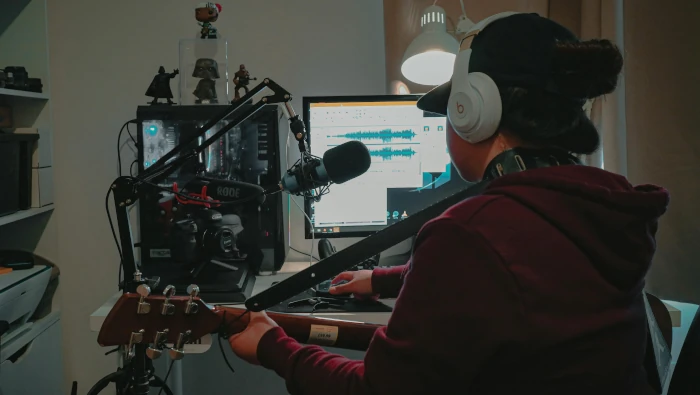Stepping into the world of audio production comes with its share of excitement and challenges. For many studio owners, the dream of crafting pristine soundscapes often clashes with the reality of technical and acoustic imperfections. Despite having top-notch equipment and a passion for music, numerous studio owners struggle to achieve professional-quality sound. This common plight stems not from a lack of effort or investment but from a fundamental misunderstanding of what truly makes a recording studio successful.
The issue often lies hidden in plain sight: a deep-seated misconception about the audio production process. Many embark on their audio journey focusing solely on collecting impressive gear, overlooking the intricate dance of recording, mixing, and mastering that must be choreographed with precision. This oversight can lead to years of subpar outputs, frustration, and missed opportunities to shine in a competitive industry.
In this introductory section, we’ll explore the root causes of these struggles and set the stage for a transformative approach to studio management. By addressing these foundational issues, studio owners can begin to refine their craft, turning their audio dreams into audible realities.
Understanding Audio Production as a Process
Imagine producing music as akin to manufacturing cars in a factory. In this factory, every component—from the smallest screw to the engine—must align perfectly to ensure the final product meets quality standards. Similarly, audio production requires a meticulous assembly line, where every step, from initial recording to final mastering, plays a crucial role in the output quality.
Unfortunately, many studio owners dive into the complex world of audio production without fully grasping this systematic approach. They often view the process in isolated segments—recording, editing, mixing, mastering—without recognizing how these elements interconnect and influence one another. This segmented view can lead to inconsistencies and a final product that falls short of industry standards.
To truly excel in studio management, it’s essential to understand that good audio production is not just about using the right microphone or software; it’s about how all elements of the process work together harmoniously. This section aims to break down the audio production process into its core components and demonstrate how a cohesive and systematic approach can prevent common pitfalls and enhance the overall sound quality.
By adopting a more holistic view, studio owners can ensure that each part of the process contributes positively to the final outcome, much like ensuring every part of a car is perfectly tuned to contribute to a smooth, efficient ride. This understanding is the first step towards achieving recordings that not only sound good but are also technically proficient and commercially viable.
The Consequences of Non-Standard Audio
Producing audio that deviates from established standards can have far-reaching consequences for studio owners. When the sound quality fails to meet the expectations of the industry, it directly impacts the studio’s reputation and its ability to attract and retain clients. In the competitive world of music production, where first impressions often make or break deals, non-standard audio can be a significant setback.
One of the most immediate effects of subpar audio production is the rejection by mainstream media channels. For instance, FM radio stations, known for their stringent quality requirements, frequently turn away recordings that do not adhere to their broadcast standards. This not only limits the exposure of the music but also diminishes the potential revenue streams for both the artists and the studios involved.
Moreover, non-standard audio can hinder an artist’s ability to compete in an increasingly digital and quality-conscious market. Platforms like Spotify, Apple Music, and YouTube have algorithms that favor higher quality tracks, affecting how music is discovered and consumed online. Poor audio quality can lead to lower streaming numbers, reduced playlist placements, and ultimately, a smaller audience reach.
The ripple effects extend beyond just the commercial implications. Substandard audio can undermine an artist’s artistic vision, distorting the intended emotional impact and authenticity of the music. This misalignment not only affects the listener’s experience but also reflects poorly on the technical competence of the studio, potentially leading to a loss of credibility and trust among clients.
This section underscores the importance of adhering to audio production standards, not just for the sake of compliance, but as a crucial element of maintaining a sustainable and successful recording studio. By understanding these consequences, studio owners can better appreciate the need for a rigorous and standard-compliant production process.
Mastering Techniques and Their Limitations
Mastering is often viewed as the final polish on a track, the step that can elevate good audio into great audio. However, there’s a common misconception among some studio owners that mastering can also fix fundamentally flawed recordings. This belief can lead to over-reliance on mastering techniques, which, while powerful, have their limitations.
Mastering is intended to enhance the balance, dynamics, and overall presentation of a track, making it consistent across various playback systems. It involves subtle adjustments in equalization, compression, limiting, and stereo enhancement. However, these adjustments are predicated on the assumption that the underlying mix is solid. If the mix contains serious flaws—like unbalanced frequencies, clipping, or poor stereo imaging—mastering can only do so much to mask these issues.
The limitations of mastering become particularly evident when dealing with recordings that have inherent technical deficiencies. For example, if a track has been recorded with inadequate equipment, in a poorly treated room, or by an inexperienced engineer, the resultant audio might be too compromised to be fully rectified by mastering alone. Issues such as noise, distortion, and uneven levels are often embedded deeply in the track and cannot be completely eliminated without affecting the integrity of the audio.
Moreover, excessive reliance on mastering to “fix” tracks can lead to a less disciplined approach to recording and mixing. This mindset might encourage cutting corners during the earlier stages of production, mistakenly believing that any issues can be addressed later. This not only undermines the quality of the final product but also stunts the development of thorough production skills.
In this section, the aim is to clarify the role of mastering within the audio production process and to stress that it should not be considered a cure-all for fundamental recording or mixing flaws. Understanding these limitations is crucial for maintaining high standards throughout every phase of audio production, ensuring that each step receives the attention and precision it requires.
Implementing a Winner Production Process

Achieving high-quality sound in a studio is not just about having the latest gear or the most skilled musicians; it’s about implementing a production process that consistently delivers excellent results. A winner production process is systematic, thorough, and adaptable, ensuring that every project meets commercial standards and artistic expectations.
The first step in establishing such a process is to meticulously plan each phase of production: recording, mixing, and mastering. This planning involves understanding the technical requirements and the artistic goals of each project, setting clear objectives for what each phase should achieve. For recording, this might mean choosing the right microphone techniques and room acoustics. For mixing, it involves balancing levels, panning, and applying effects judiciously to enhance the overall sound without overshadowing the original recording.
Crucially, a winner production process also includes regular testing and quality checks. This could mean conducting A/B comparisons with professional tracks, gathering feedback from unbiased listeners, or simply taking breaks and revisiting mixes with fresh ears. Each test helps identify potential issues before they become costly or damaging to the final product.
Another key component is continuous improvement. This involves staying updated with the latest production techniques, software updates, and industry trends. It also means being open to feedback and willing to make changes to the process based on what has or hasn’t worked in the past.
Implementing such a rigorous process requires commitment and discipline, but the rewards are significant. It not only improves the quality of the audio output but also enhances the studio’s reputation, attracts better projects, and ultimately, increases profitability.
In this section, we discuss practical steps and strategies for setting up and maintaining a winner production process in your studio, ensuring that your final outputs are not just good, but exceptional. This involves a blend of technical acuity, creative insight, and proactive management—all key ingredients for success in the competitive world of audio production.
The Three Pillars of Audio Production
To truly excel in the field of audio production, mastering the three fundamental pillars—recording, mixing, and mastering—is essential. Each pillar plays a distinct and crucial role in the creation of high-quality audio, and understanding how to optimize each stage is key to producing sound that stands out in today’s competitive music industry.
Recording: The Foundation
Recording is the first and perhaps most critical step in the audio production process. This stage is about capturing the raw material of your music in the cleanest, clearest way possible. It involves selecting the right microphones, setting up the recording environment to minimize unwanted noise and echoes, and ensuring that the performance is captured with precision and clarity. Getting the recording right sets the tone for the entire production process, as errors or deficiencies at this stage can be difficult to correct later on.
Mixing: The Art
Mixing is where technical skill meets creativity. In this stage, the raw tracks are blended together to form a coherent whole. The mixer adjusts levels, panning, and time-based effects like reverb and delay to create a balanced and dynamic soundscape. Equalization is crucial here, as it helps to carve out a sonic space for each element, ensuring that no instrument overwhelms another. Mixing is an art form in itself, requiring a deep understanding of the musical and sonic objectives of the project to enhance the emotional and aesthetic impact of the track.
Mastering: The Final Polish
Mastering is the final step before a track is released to the world. This pillar is about fine-tuning the mixed audio to ensure it translates well across all playback systems—from giant club speakers to smartphone earbuds. Mastering engineers apply subtle enhancements and technical corrections, making final adjustments to the track’s overall loudness, ensuring uniformity and cohesion across an album, and embedding the necessary metadata. This stage is critical for achieving a professional, competitive sound that meets industry standards.
Understanding and mastering these three pillars—recording, mixing, and mastering—empowers audio professionals to produce work that not only sounds great but also resonates with listeners across various platforms. In this section, we dive deep into each pillar, providing insights and tips to help studio owners and music producers elevate their craft to the highest professional standards.

